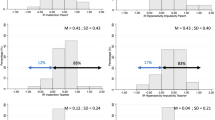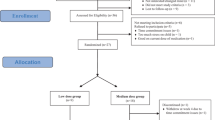Abstract
This investigation examined the relationship between methylphenidate (MPH) and the learning and recall of paired associations by children with attention deficit disorder with hyperactivity (ADDH). Forty-five children with ADDH were randomly assigned to one of three groups (novel, partial mastery, and mastery learning) that varied in the amount of previous learning of paired associations and participated in a double-blind, placebo-control, repeated-measures-across-dose (crossover) design. Each child received four doses of MPH (5 mg, 10 mg, 15 mg, and 20 mg) and a placebo in a random, counterbalanced sequence. The results indicated that both the rate of acquisition and accuracy in learning paired associations were significantly, but differentially, affected by MPH dose and the degree of learning mastery. The implications of these results for psychopharmacological research and the monitoring of psychostimulant effects on children's learning performance in academic settings are discussed.
Similar content being viewed by others
References
American Psychiatric Association. (1980).Diagnostic and statistical manual of mental disorders (3rd ed.). Washington, DC: Author.
Barkley, R. A. (1981).Hyperactive children: A handbook for diagnosis and treatment. New York: Guilford Press.
Conners, C. K. (1971). Drugs in the management of children with learning disabilities. In L. Tarnopol (Ed.),Learning disorders in children: Diagnosis, medication, education (pp. 287–293). Boston: Little, Brown.
Conners, C. K., Eisenberg, L., & Sharpe, L. (1964). Effects of methylphenidate (Ritalin) on paired-associate learning and Porteus maze performance in emotionally disturbed children.Journal of Consulting Psychology, 28, 14–22.
Douglas, V., Barr, R. G., O'Neill, M. E., & Britton, B. G. (1986). Short term effect of methyl-phenidate on the cognitive, learning and academic performance of children with attentional deficit disorder in the laboratory and the classroom.Journal of Child Psychology and Psychiatry, 27, 191–211.
Dunn, L. M., & Dunn, L. M. (1981).Peabody Picture Vocabulary Test-Revised. Circle Pines, MN: American Guidance Service.
Evans, R. W., Gualtieri, C. T., & Amara, I. (1986). Methylphenidate and memory: Dissociated effects in hyperactive children.Psychopharmacology, 90, 211–216.
Gan, J., & Cantwell, D. P. (1982). Dosage effects of methylphenidate on paired associate learning: Positive/negative placebo responders.Journal of the American Academy of Child Psychiatry, 21, 237–242.
Gittelman-Klein, R., & Klein, D. F. (1975). Are behavioral and psychometric changes related in methylphenidate-treated, hyperactive children?International Journal of Mental Health, 4, 182–198.
Gualtieri, C. T., Wargin, W., Kanoy, R., Patrick, K., Shen, C. D., Youngblood, W., Mueller, R. A., & Breese, G. R. (1982). Clinical studies of methylphenidate serum levels in children and adults.Journal of the American Academy of Child Psychiatry, 21, 19–26.
Hasher, L., & Zacks, R. T. (1979). Automatic and effortful processing in memory.Journal of Experimental Psychology, 108, 356–388.
Hollingshead, A. B. (1975).Four Factor Index of Social Status. New Haven, CT: Yale University Press.
Kinsbourne, M., & Swanson, J. M. (1979). Models of hyperactivity: Implications for diagnosis and treatment. In R. L. Trites (Ed.),Hyperactivity in children: Etiology, measurement, and treatment implications (pp. 1–20). Baltimore: University Park Press.
Pelham, W. E., Bender, M. E., Caddell, J., Booth, S., & Moorer, S. H. (1985). Methylphenidate and children with attention deficit disorder.Archives of General Psychiatry, 42, 948–952.
Pelham, W. E., Sturges, J., Hoza, J., Schmidt, C., Bijlsma, J. J., Milich, R., & Moorer, S. (1987). Sustained release and standard methylphenidate effects on cognitive and social behavior in children with attention deficit disorder.Pediatrics, 80, 491–501.
Physicians' Desk Reference. (1980). Oradell, NJ: Medical Economics.
Rapoport, J. L., Buchsbaum, M. S., Weingartner, H., Zahn, T. P., Ludlow, C., & Mikkelsen, E. J. (1980). Dextroamphetamine: Cognitive and behavioral effects in normal and hyperactive boys and normal men.Archives of General Psychiatry, 37, 933–943.
Rapport, M. D., & DuPaul, G. J. (1988, May).Attention deficit hyperactivity disorder and methylphenidate: The relationship between gross body weight and drug response in children. Paper presented at the National Institute of Mental Health, Pharmacologic and Somatic Treatments Research Consortium, Key Biscayne, FL.
Rapport, M. D., DuPaul, G. J., & Kelly, K. L. (1989). Attention deficit-hyperactivity disorder and methylphenidate: The relationship between gross body weight and drug response in children.Psychopharmacology Bulletin, 25(2).
Rapport, M. D., DuPaul, G. J., Stoner, G., & Jones, J. T. (1986). Comparing classroom and clinic measures of attention deficit disorder. Differential, idiosyncratic, and doseresponse effects of methylphenidate.Journal of Consulting and Clinical Psychology, 54, 334–341.
Rapport, M. D., Jones, J. T., DuPaul, G. J., Kelly, K., Gardner, M., Tucker, S. B., & Schoeler, T. (1987). Attention deficit disorder and methylphenidate: Group and single-subject analyses of dose effects on attention in clinic and classroom settings.Journal of Clinical Child Psychology, 16, 329–338.
Rapport, M. D., Stoner, G., DuPaul, G. J., Birmingham, B. K., & Tucker, S. (1985). Methylphenidate in hyperactive children: Differential effects of dose on academic, learning, and social behavior.Journal of Abnormal Child Psychology, 13, 227–243.
Rapport, M. D., Stoner, G., DuPaul, G. J., Kelly, K. L., Tucker, S. B., & Schoeler, T. (1988). Attention deficit disorder and methylphenidate: A multilevel analysis of dose-response effects on children's impulsivity across settings.Journal of the American Academy of Child and Adolescent Psychiatry, 27, 60–69.
Rie, E. D., & Rie, H. E. (1977). Recall, retention and Ritalin.Journal of Consulting and Clinical Psychology, 45, 967–972.
Routh, D. K., Schroeder, C. S., & O'Tuama, L. (1974). Development of activity level in children.Developmental Psychology, 10, 163–168.
Safer, D. J., & Krager, M. D. (1983). Trends in medication treatment of hyperactive school children.Clinical Pediatrics, 22, 500–504.
Solanto, M. V., & Conners, C. K. (1982). A dose-response and time-action analysis of autonomic and behavioral effects of methylphenidate in attention deficit disorder with hyperactivity.Psychophysiology, 19, 658–667.
Sprague, R. L. (1984). Preliminary report of cross-cultural study and cognitive strategies of ADD children. In L. M. Bloomingdale (Ed.),Attention deficit disorder: Diagnostic, cognitive, and therapeutic understanding (pp. 211–219). New York: Spectrum.
Sprague, R. L., & Sleator, E. K. (1977). Methylphenidate in hyperactive children: Differences in dose effects on learning and social behavior.Science, 198, 1274–1276.
Stevens, R. S., Pelham, W. E., & Skinner, R. (1984). State-dependent and main effects of methylphenidate and pemoline on paired-associate learning and spelling in hyperactive children.Journal of Consulting and Clinical Psychology, 53, 104–113.
Stevenson, H. W. (1972).Children's learning. New York: Appleton-Century-Crofts.
Swanson, J. M. (1985). Measures of cognitive functioning appropriate for use in pediatric pharmacological research studies.Psychopharmacology Bulletin, 21, 887–890.
Swanson, J. M., Barlow, A., & Kinsbourne, M. (1979). Task specificity of response to stimulant drugs in laboratory tests.Psychopharmacologia, 25, 262–274.
Swanson, J. M., & Kinsbourne, M. (1979). The cognitive effects of stimulant drugs on hyperactive children. In G. A. Hale & M. Lewis (Eds.),Attention and cognitive development (pp. 249–274). New York: Plenum.
Swanson, J. M., Kinsbourne, M., Roberts, W., & Zucker, K. (1978). Time-response analysis of the effect of stimulant medication on the learning ability of children referred for hyperactivity.Pediatrics, 61, 21–29.
Swanson, J. M., Sandman, C. A., Deutsch, C., & Baren, M. (1983). Methylphenidate hydrochloride given with or before breakfast: I. Behavioral, cognitive, and electrophysiologic effects.Pediatrics, 72, 49–55.
Thurston, C. M., Sobol, M. P., Swanson, J. M., & Kinsbourne, M. (1979). Effects of methylphenidate (Ritalin) on selective attention in hyperactive children.Journal of Abnormal Child Psychology, 7, 471–481.
Vyse, S. A., & Rapport, M. D. (1989). The effects of methylphenidate on learning in children with ADDH: The stimulus equivalence paradigm.Journal of Consulting and Clinical Psychology, 57, 425–435.
Weingartner, H., Rapoport, J. L., Buchsbaum, M. S., Bunney, W. E., Ebert, M. H., Mikkelsen, E. J., & Caine, E. D. (1980). Cognitive processes in normal and hyperactive children and their response to amphetamine treatment.Journal of Abnormal Psychology, 89, 25–37.
Weiss, B., & Laties, V. G. (1962). Enhancement of human performance by caffeine and the amphetamines.Pharmacological Review, 14, 1–36.
Werry, J., Sprague, R., & Cohen, M. (1975). Conners Teacher Rating Scale for use in drug studies with children—An empirical study.Journal of Abnormal Child Psychology, 3, 217–229.
Winer, B. J. (1971).Statistical principles in experimental design (2nd ed.). New York: McGraw-Hill.
Author information
Authors and Affiliations
Additional information
The authors wish to acknowledge and express their sincere appreciation to the graduate and undergraduate student members of the Children's Learning Clinic.
Rights and permissions
About this article
Cite this article
Rapport, M.D., Quinn, S.O., DuPaul, G.J. et al. Attention deficit disorder with hyperactivity and methylphenidate: The effects of dose and mastery level on children's learning performance. J Abnorm Child Psychol 17, 669–689 (1989). https://doi.org/10.1007/BF00917730
Revised:
Issue Date:
DOI: https://doi.org/10.1007/BF00917730




